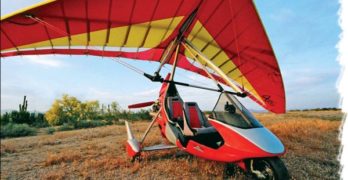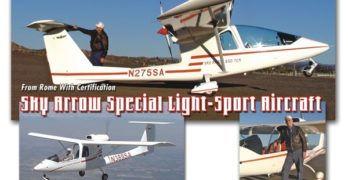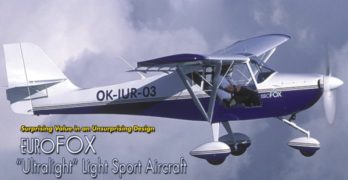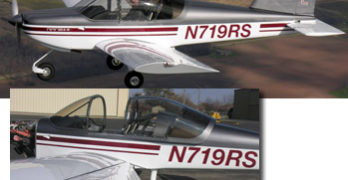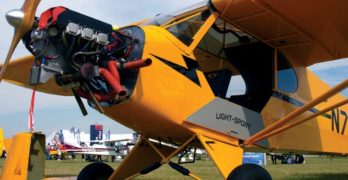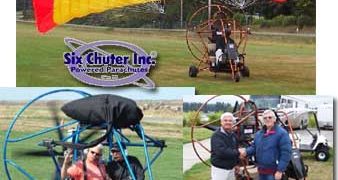First weight-shift S-LSA sets the bar high
In street vernacular, the term
“crotch rocket” refers to a lean,
lightweight, high-performance
motorcycle. Sometimes called sport
bikes, these machines have become
radically snazzy in modern years by
the addition of rakish body panels.
Sport bikes accelerate like a rocket.
They corner tightly, and they turn
heads wherever they go.
The first weight-shift trike to earn
special light-sport aircraft (S-LSA) approval,
the Air Creation Tanarg might
be compared to just such a vehicle. In
fact, that’s precisely how its French
manufacturer describes its newest
machine.
Yet, while sport bikes are touchy
and have less margin for error than
other motorcycles, Air Creation’s flying
sport bike is highly stable with predictable
handling. Compare Tanarg’s
performance to other trikes, and it
comes out as a top-of-the-line entry.
The name Tanarg comes from the
highest mountain range in the Ardeche
region of southern France, not
far from the Air Creation factory.
Search Results for : CT AND hand control
Not finding exactly what you expected? Try our advanced search option.
Select a manufacturer to go straight to all our content about that manufacturer.
Select an aircraft model to go straight to all our content about that model.
Sky Arrow Special Light-Sport Aircraft
Ultralight pilots
may not believe the Sky Arrow has achieved Part 23 certified status the same as a Cessna or Cirrus, but it has done precisely that. This sleek Italian tandem 2-seater earned European JAR/VLA certification and, after careful review, FAA gave its approval under international reciprocity agreements.
That makes the Sky Arrow something like the RANS S-7, which won approval under FAA’s last new certification program, Primary category. As a side note, the Kansas company also received its S-LSA airworthiness certificate with less challenge than companies that had not taken the earlier effort
Therefore, once FAA introduced the Light-Sport Aircraft regulation, few were surprised that the Sky Arrow could win approval. In fact, the aircraft was number 18 out of ranks that have now swelled to 40 new models approved.
Let’s forget about FAA approval for the moment and focus on the Sky Arrow’s ability to fly much like an ultralight.
Surprising Value in an Unsurprising Design
On September 1, 2004, when the Federal Aviation Administration (FAA) released the long-anticipated Sport Pilot and Light-Sport Aircraft regulations, a new aviation segment called light sport aircraft (LSA) was created. Some saw LSA as a bridge between ultralights and general aviation aircraft, but are LSA so different from ultralights? The answer is a mixed yes and no.
Yes, many aircraft look different in that the extra weight they may possess allows them to have full composite fuselages, a panel full of instruments even including fancy glass cockpit hardware, plus they can be delivered ready to fly even as 2-seaters. That’s different than our ultralight trainers or our amateur-built recreational aircraft that resemble those trainers. Prices for these light sport aircraft have pushed them beyond the budgets of many pilots.
On the other hand, these aircraft needn’t be all that different from ultralights. The new rule doesn’t require that they weigh the maximum 1,320 pounds.
Flying the Rans S-19; SLSA Version in Process
Most light aircraft enthusiasts know Rans. One of America’s leading builders the Hays, Kansas company has delivered more than 4,000 aircraft. Rans achieved Primary Category certification for their high wing tandem S-7 Courier in the 1990s. That program fizzled through no fault of Rans’ but after meeting industry consensus (ASTM) standards their S-7LS again won approval as a Special Light-Sport Aircraft. *** Sales of the model ranks the company at #17…5th among U.S. builders. That position seems bound to rise when Rans adds the low wing side-by-side S-19 as a SLSA (so far it’s been offered as a 51% kit). Look for their announcement at the Sebring Expo. *** Recently I attended EAA’s Hall of Fame ceremony as designer Randy Schlitter was inducted into the Homebuilders category. Since he flew to Oshkosh I got the chance to fly his ’19 for an article to appear in EAA’s Sport Pilot.
Certifying LSA
A Review of the Industry Consensus Standards Method
In the aviation world, the new light sport aircraft category is all the rage, with interest at aviation trade shows climbing off the charts. New aircraft certified using ASTM International industry consensus standards recently reached model number 50, with all approvals coming in less than two years, a record in aviation history worldwide.
Doing things correctly and quickly is not uncommon in the world of light sport aircraft. This is a highly entrepreneurial activity populated by get-it-done businessmen and women who are highly motivated to get their nascent industry off the ground – literally.
Welcome to Committee F37
ASTM International’s Committee F37 on Light Sport Aircraft is just five years old, yet it has produced, from scratch, specifications for design, performance, quality acceptance tests and safety monitoring for LSA. ASTM standards guide the preparation of pilot operating handbooks, maintenance manuals, and a system of service bulletins to advise consumers of maintenance needed to keep their aircraft in good operating condition.
The Technical Work of F37
The Technical Work of F37
Light sport aircraft industry stakeholders engaged in the ASTM standards initiative include manufacturers of airplanes (conventional fixed wing aircraft), powered parachutes, weight shift controlled aircraft, gliders, gyroplanes, and lighter-than-air. In addition, F37 volunteers come from the flight instructor community, recreational pilots, parts manufacturers, and the regulatory community.
Committee F37’s work embraces:
Minimum safety, performance and flight proficiency requirements.
Quality assurance to install manufacturing controls confirming that aircraft meet design criteria.
Completed aircraft production acceptance tests and procedures assuring that completed aircraft meet reported performance as demonstrated in the prototype aircraft, including design limits such as empty weight; center of gravity; performance specifications; controllability and maneuverability; longitudinal, lateral, and yaw stability; stall speeds; handling characteristics; engine cooling and operating characteristics; propeller limits; systems function; and folding or removable lifting surfaces.
A plan for continued airworthiness, including methods for monitoring and maintaining continued operational safety, and processes for identifying, reporting and remedying safety-of-flight issues.
Six Chuter Powered Parachutes Joins the LSA Parade
As the deadline approaches for ultralights needing to convert to LSA, companies are recognizing the need to get products ready for the new age of light-sport. The latest: Six Chuter, one of the original producers of powered parachutes…but one that took their time hopping on the bandwagon. *** Director of Communications, Doug Maas (who also completed the production test flight), reports the company developed more than 1,000 pages of documentation to meet ASTM standards. The voluminous information came from creating a brand-new carriage with multiple configurations. Legend (which is SLSA #58) can be a single seater, tandem seater, or a somewhat rare side-by-side powered parachute (photo). This is a novel approach to certification and explains the delay for the company’s SLSA entry. Six Chuter said, “The Legend XT SSDC (Side-by-Side Dual Control) is our SLSA development model targeted for flight instructors and others who enjoy a side-by-side configuration.” Six Chuter will offer the XT SSDC and other models as either fully-built SLSA or as ELSA kits.
The EuroFox Offers Affordable Quality
Repatriate means “to restore or return to the country of origin.” That’s exactly what’s happening with the Aeropro EuroFox, an Eastern European-built light-sport aircraft (LSA) based on American design work. It’s coming to this country as a ready-to-fly LSA through importer Rollison Light Sport Aircraft (RLSA).
Just as a car made in Detroit may incorporate a considerable number of parts that were manufactured overseas, LSA can be a combination of United States- and foreign-built parts as well. That’s not unusual in the aviation world. Consider that a new Boeing airplane is likely to have many parts manufactured in other countries. When Boeing competes against Airbus, it may be important to give some work to a country that may buy billions of dollars of airliners. Therefore, even a Boeing aircraft is not 100 percent made in America.
In the LSA world, aircraft manufactured in foreign countries may be delivered to the United States without instruments or other accessory equipment, or that equipment may have been built in the United States and shipped overseas for installation in the aircraft.
Aeropro EuroFox
His Rollison Light Sport Aircraft (RLSA) company has been building a fleet of aircraft for sale from European sources. Rollison has represented numerous brands over the years he’s been involved in light-sport aviation. First he represented American brands and later European. Recently he’s traveled to South America to see what’s available. Today, Rollison sells the Remos G-3 Mirage, the Ikarus-Comco C42, and the EuroFox. He’s associated with Allistair Wilson who is making his own Astra trikes. Of the fixed-wing models in RLSA’s hangar, the EuroFox is the most modestly priced with the C42 next highest and the G-3 as RLSA’s top-of-the-line model.
More Than Familiar?
Many Ultralight Flying! readers will say the EuroFox looks to be a copy of a Kitfox. In fact, says Rob Rollison, this simply isn’t true.
The EuroFox certainly shares heritage with the Kitfox but is actually a downstream development of the Avid Flyer. In the Slovak Republic, where the four founders of Aeropro live, plans were used to build an Avid.
Able Flight Doing Good Work: Brad’s New Ticket
We all know aviation needs more young pilots. And who can’t like an organization that helps people with disabilities. Put those points together you get a winning piece of news like 22-year old Brad Jones earning his Sport Pilot certificate in the Sky Arrow SLSA. *** The happy moment came only a few days after the one-year anniversary of the accident that left him paralyzed. By achieving his pilot license, Brad has become the first Able Flight Scholarship winner to complete the training. *** Brad’s flight instructors Mitch Hansen and Mike Davidson recommended him for his FAA examination and he passed with flying colors. Flying the specially-adapted Sky Arrow provided by Hansen Air Group, Brad logged just over 25 hours of instruction before his checkride with examiner Ben Methvin, Jr. *** Reflecting on his accomplishment, Brad said, “It has boosted my confidence and what I feel I can do.
- « Previous Page
- 1
- …
- 42
- 43
- 44
- 45
- 46
- …
- 62
- Next Page »


